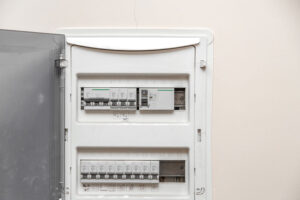Electrical problems can be frustrating and potentially hazardous for homeowners. Whether you’re experiencing flickering lights, tripping breakers, or faulty outlets, understanding common electrical issues and knowing how to solve them can save you time, money, and ensure the safety of your home. In this blog post, we will explore five of the most common electrical problems encountered in homes and provide practical solutions to address them effectively.

Flickering Lights
Flickering lights are not only annoying but can also indicate an underlying electrical problem. The most common causes include loose or faulty light bulbs, poor electrical connections, or overloaded circuits. To solve this issue, start by checking and tightening the light bulbs. If the problem persists, inspect the light fixture connections for any loose or damaged wiring. If necessary, consult a licensed electrician to address wiring issues or consider redistributing electrical loads to balance the circuits.
Tripping Circuit Breakers
Tripping circuit breakers occur when the electrical load exceeds the capacity of the circuit. This can happen due to overloaded circuits, short circuits, or ground faults. To solve this problem, identify the circuit that is tripping and determine what appliances or devices are connected to it. If the circuit is overloaded, reduce the load by unplugging or redistributing the devices. If you can’t identify the cause, it may be a sign of a faulty appliance or wiring issue, and it’s recommended to seek professional assistance.
Dead Outlets
Dead outlets, where no power is supplied to the socket, can be caused by various factors. The most common reasons are tripped GFCI (Ground Fault Circuit Interrupter) outlets, loose wiring, or a faulty outlet. Start by checking if any nearby GFCI outlets have tripped and reset them. If that doesn’t solve the problem, inspect the wiring connections at the dead outlet. Ensure all connections are secure and tighten any loose screws. If the outlet remains non-functional, it may need to be replaced by a qualified electrician.
Overheating Switches or Outlets
If you notice switches or outlets becoming hot to the touch, it’s a sign of a potential fire hazard. Overheating is often caused by loose connections, faulty wiring, or overloaded circuits. To address this issue, turn off power to the affected switch or outlet at the circuit breaker and avoid using it until the problem is resolved. Check for loose connections and tighten them if necessary. If the problem persists, it’s crucial to consult an electrician to investigate the underlying cause and make the necessary repairs.
At Hayes & Lunsford Electric Inc., we specialize in designing and installing Lighting Systems, Power Distribution, Emergency Generators, Fire Alarms, Security Systems, Voice & Cabling, Audio Visual Systems, Medium Voltage Systems and ARC Flash Studies. Contact us today at (864) 297-3198 (SC) or (828) 412-5852 (NC) or visit us online for more information!

